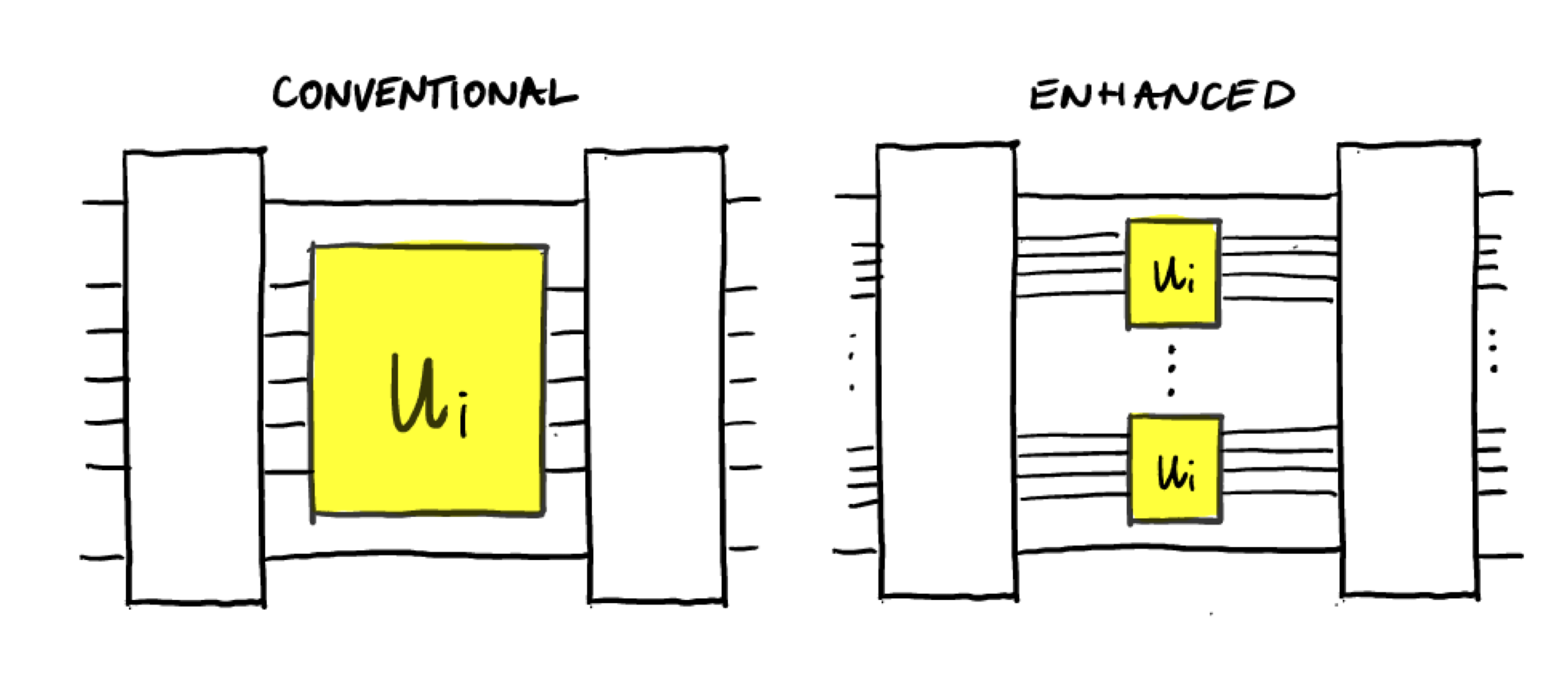Note
Click here to download the full example code
Quantum advantage in learning from experiments¶
Author: Joseph Bowles — Posted: 18 April 2022. Last updated: 30 June 2022.
This demo is based on the article Quantum advantage in learning from experiments [1] by Hsin-Yuan Huang and co-authors. The article investigates the following question:
How useful is access to quantum memory for quantum machine learning?
They show that access to quantum memory can make a big difference, and prove that there exist learning problems for which algorithms with quantum memory require exponentially less resources than those without. We look at one learning task studied in [1] for which this is the case.
The learning task¶
The learning task we focus on involves deciding if a unitary is time-reversal symmetric (we’ll call them T-symmetric) or not. Mathematically, time-reversal symmetry in quantum mechanics involves reversing the sense of \(i\) so that \(i \rightarrow -i\). Hence, a unitary \(U\) is T-symmetric if
Now for the learning task. Let’s say we have a bunch of quantum circuits \(U_1, \cdots, U_n\), some of which are T-symmetric and some not, but we are not told which ones are which.
The task is to design an algorithm to determine which of the \(U\)’s are T-symmetric and which are not, given query access to the unitaries. Note that we do not have any labels here, so this is an unsupervised learning task. To make things concrete, let’s consider unitaries acting on 8 qubits. We will also limit the number of times we can use each unitary:
qubits = 8 # the number of qubits on which the unitaries act
n_shots = 100 # the number of times we can use each unitary
Experiments with and without a quantum memory¶
To tackle this task we consider experiments with and without quantum memory. We also assume that we have access to a single physical realization of each unitary; in other words, we do not have multiple copies of the devices that implement \(U_i\).
An experiment without quantum memory can therefore only make use of a single query to \(U_i\) in each circuit, since querying \(U_i\) again would require storing the state of the first query in memory and re-using the unitary. In the paper these experiments are called conventional experiments.
Experiments with quantum memory do not have the limitations of conventional experiments. This means that multiple queries can be made to \(U_i\) in a single circuit, which can be realized in practice by using a quantum memory. These experiments are called quantum-enhanced experiments.
Note that we are not comparing classical and quantum algorithms here, but rather two classes of quantum algorithms.
The conventional way¶
First, we will try to solve the task with a conventional experiment. Our strategy will be as follows:
For each \(U_i\), we prepare
n_shotscopies of the state \(U_i\vert0\rangle\) and measure each state to generate classical measurement data.Use an unsupervised classical machine learning algorithm (kernel PCA), to try and separate the data into two clusters corresponding to T-symmetric unitaries vs. the rest.
If we succeed in clustering the data then we have successfully managed to discriminate the two classes!
To generate the measurement data, we will measure the states \(U_i\vert0\rangle\) in the \(y\) basis. The local expectation values take the form
where \(\sigma_y^{(i)}\) acts on the \(i^{\text{th}}\) qubit.
Using the fact that \(\sigma_y^*=-\sigma_y\) and the property \(U^*=U\) for T-symmetric unitaries, one finds
Since \(E_i\) is a real number, the only solution to this is \(E_i=0\), which implies that all local expectations values are 0 for this class.
For general unitaries it is not the case that \(E_i=0\), and so it seems as though this will allow us to discriminate the two classes of circuits easily. However, for general random unitaries the local expectation values approach zero exponentially with the number of qubits: from finite measurement data it can still be very hard to see any difference! In fact, in the article exponential separations between learning with and without quantum memory [2] it is proven that using conventional experiments, any successful algorithm must use the unitaries an exponential number of times.
Let’s see how this looks in practice. First we define a function to generate random unitaries, making use of Pennylane’s RandomLayers template. For the time-symmetric case we will only allow for Y rotations, since these unitaries contain only real numbers, and therefore result in T-symmetric unitaries. For the other unitaries, we will allow rotations about X,Y, and Z.
import pennylane as qml
from pennylane.templates.layers import RandomLayers
from pennylane import numpy as np
np.random.seed(234087)
layers, gates = 10, 10 # the number of layers and gates used in RandomLayers
def generate_circuit(shots):
"""
generate a random circuit that returns a number of measuement samples
given by shots
"""
dev = qml.device("default.qubit", wires=qubits, shots=shots)
@qml.qnode(dev)
def circuit(ts=False):
if ts == True:
ops = [qml.RY] # time-symmetric unitaries
else:
ops = [qml.RX, qml.RY, qml.RZ] # general unitaries
weights = np.random.rand(layers, gates) * np.pi
RandomLayers(weights, wires=range(qubits), rotations=ops, seed=np.random.randint(0, 10000))
return [qml.sample(op=qml.PauliY(q)) for q in range(qubits)]
return circuit
let’s check if that worked:
Out:
[[-1 1 -1]
[-1 -1 -1]
[-1 -1 1]
[ 1 1 1]
[-1 -1 1]
[-1 -1 -1]
[-1 1 -1]
[-1 1 1]]
[[ 1 1 -1]
[-1 1 1]
[ 1 -1 1]
[-1 1 1]
[ 1 -1 -1]
[-1 -1 -1]
[-1 1 -1]
[-1 1 1]]
Now we can generate some data. The first 30 circuits in the data set are T-symmetric and the second 30 circuits are not. Since we are in an unsupervised setting, the algorithm will not know this information.
Before feeding the data to a clustering algorithm, we will process it a
little. For each circuit, we calculate the mean and the variance of each
output bit and store this in a vector of size 2*qubits. These
vectors make up our classical data set.
def process_data(raw_data):
"convert raw data to vectors of means and variances of each qubit"
raw_data = np.array(raw_data)
nc = len(raw_data) # the number of circuits used to generate the data
nq = len(raw_data[0]) # the number of qubits in each circuit
new_data = np.zeros([nc, 2 * nq])
for k, outcomes in enumerate(raw_data):
means = [np.mean(outcomes[q, :]) for q in range(nq)]
variances = [np.var(outcomes[q, :]) for q in range(nq)]
new_data[k] = np.array(means + variances)
return new_data
data = process_data(raw_data)
Now we use scikit-learn’s kernel PCA package to try and cluster the data. This performs principal component analysis in a high dimensional feature space defined by a kernel (below we use the radial basis function kernel).
from sklearn.decomposition import KernelPCA
from sklearn import preprocessing
kernel_pca = KernelPCA(
n_components=None, kernel="rbf", gamma=None, fit_inverse_transform=True, alpha=0.1
)
# rescale the data so it has unit standard deviation and zero mean.
scaler = preprocessing.StandardScaler().fit(data)
data = scaler.transform(data)
# try to cluster the data
fit = kernel_pca.fit(data).transform(data)
Let’s plot the result. Here we look at the first two principal components.
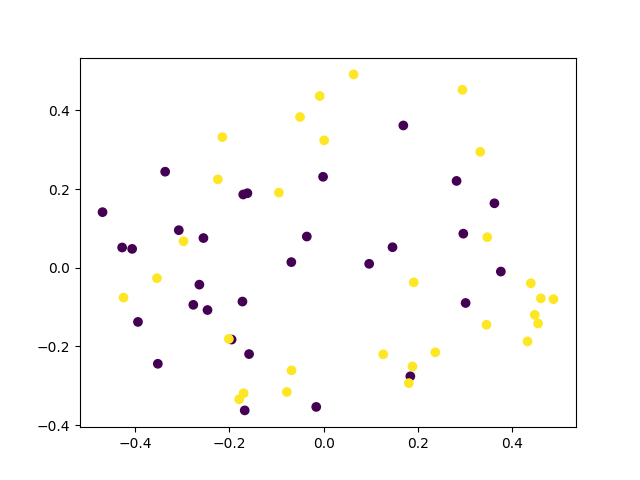
Looks like the algorithm failed to cluster the data. We can try to get a separation by increasing the number of shots. Let’s increase the number of shots by 100 and see what happens.
n_shots = 10000 # 100 x more shots
raw_data = []
for ts in [True, False]:
for __ in range(circuits):
circuit = generate_circuit(n_shots)
raw_data.append(circuit(ts=ts))
data = process_data(raw_data)
scaler = preprocessing.StandardScaler().fit(data)
data = scaler.transform(data)
fit = kernel_pca.fit(data).transform(data)
plt.scatter(fit[:, 0], fit[:, 1], c=c)
plt.show()
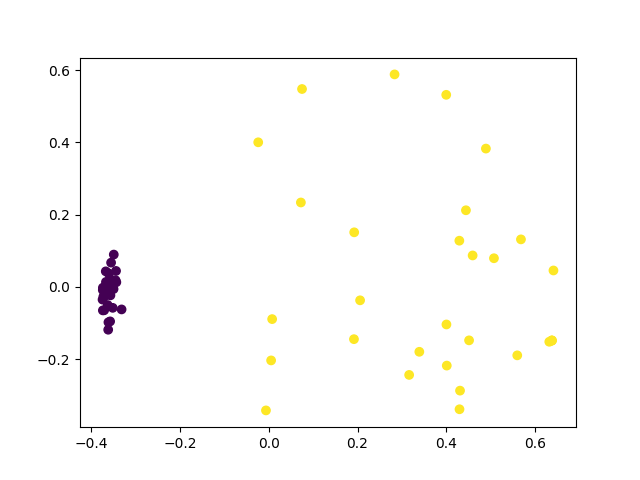
Now we have a separation, however we required a lot of shots from the quantum circuit. As we increase the number of qubits, the number of shots we need will scale exponentially (as shown in [2]), and so conventional strategies cannot learn to separate the data efficiently.
The quantum-enhanced way¶
Now let’s see what difference having a quantum memory can make. Instead of using a single unitary to generate measurement data, we will make use of twice the number of qubits, and apply the unitary twice:
In practice, this could be done by storing the output state from the
first unitary in quantum memory and preparing the same state by using
the unitary again. Let’s define a function enhanced_circuit() to
implement that. Note that since we now have twice as many qubits, we use
half the number of shots as before so that the total number of uses of
the unitary is unchanged.
n_shots = 50
qubits = 8
dev = qml.device("default.qubit", wires=qubits * 2, shots=n_shots)
@qml.qnode(dev)
def enhanced_circuit(ts=False):
"implement the enhanced circuit, using a random unitary"
if ts == True:
ops = [qml.RY]
else:
ops = [qml.RX, qml.RY, qml.RZ]
weights = np.random.rand(layers, n_shots) * np.pi
seed = np.random.randint(0, 10000)
for q in range(qubits):
qml.Hadamard(wires=q)
qml.broadcast(
qml.CNOT, pattern=[[q, qubits + q] for q in range(qubits)], wires=range(qubits * 2)
)
RandomLayers(weights, wires=range(0, qubits), rotations=ops, seed=seed)
RandomLayers(weights, wires=range(qubits, 2 * qubits), rotations=ops, seed=seed)
qml.broadcast(
qml.CNOT, pattern=[[q, qubits + q] for q in range(qubits)], wires=range(qubits * 2)
)
for q in range(qubits):
qml.Hadamard(wires=q)
return [qml.sample(op=qml.PauliZ(q)) for q in range(2 * qubits)]
Now we generate some raw measurement data, and calculate the mean and variance of each qubit as before. Our data vectors are now twice as long since we have twice the number of qubits.
raw_data = []
for ts in [True, False]:
for __ in range(circuits):
raw_data.append(enhanced_circuit(ts))
data = process_data(raw_data)
Let’s throw that into Kernel PCA again and plot the result.
kernel_pca = KernelPCA(
n_components=None, kernel="rbf", gamma=None, fit_inverse_transform=True, alpha=0.1
)
scaler = preprocessing.StandardScaler().fit(data)
data = scaler.transform(data)
fit = kernel_pca.fit(data).transform(data)
c = np.array([0 for __ in range(circuits)] + [1 for __ in range(circuits)])
plt.scatter(fit[:, 0], fit[:, 1], c=c)
plt.show()
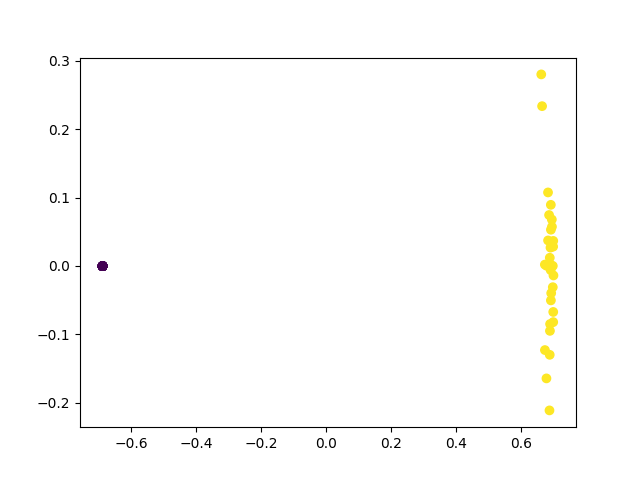
Kernel PCA has perfectly separated the two classes! In fact, all the T-symmetric unitaries have been mapped to the same point. This is because the circuit is actually equivalent to performing \(U^TU\otimes \mathbb{I}\vert 0 \rangle\), which for T-symmetric unitaries is just the identity operation.
To see this, note that the Hadamard and CNOT gates before \(U_i\otimes U_i\) map the \(\vert0\rangle\) state to the maximally entanged state \(\vert \Phi^+\rangle = \frac{1}{\sqrt{2}}(\vert 00...0\rangle+ \vert11...1\rangle\), and the gates after \(U_i\otimes U_i\) are just the inverse transformation. The probability that all measurement outcomes give the result \(+1\) is therefore.
A well known fact about the maximally entanged state is that \(U\otimes \mathbb{I}\vert\Phi^+\rangle= \mathbb{I}\otimes U^T\vert\Phi^+\rangle\). The probabilty is therefore
For T-symmetric unitaries \(U_i^T=U_i^\dagger\), so this probability is equal to one: the \(11\cdots 1\) outcome is always obtained.
If we look at the raw measurement data for the T-symmetric unitaries:
np.array(raw_data[0])[:, 0:5] # outcomes of first 5 shots of the first T-symmetric circuit
Out:
tensor([[1, 1, 1, 1, 1],
[1, 1, 1, 1, 1],
[1, 1, 1, 1, 1],
[1, 1, 1, 1, 1],
[1, 1, 1, 1, 1],
[1, 1, 1, 1, 1],
[1, 1, 1, 1, 1],
[1, 1, 1, 1, 1],
[1, 1, 1, 1, 1],
[1, 1, 1, 1, 1],
[1, 1, 1, 1, 1],
[1, 1, 1, 1, 1],
[1, 1, 1, 1, 1],
[1, 1, 1, 1, 1],
[1, 1, 1, 1, 1],
[1, 1, 1, 1, 1]], requires_grad=True)
We see that indeed this is the only measurement outcome.
To make things a bit more interesting, let’s add some noise to the
circuit. We will define a function noise_layer(epsilon) that adds
some random single qubit rotations, where the maximum rotation angle is
epsilon.
def noise_layer(epsilon):
"apply a random rotation to each qubit"
for q in range(2 * qubits):
angles = (2 * np.random.rand(3) - 1) * epsilon
qml.Rot(angles[0], angles[1], angles[2], wires=q)
We redefine our enhanced_circuit() function with a noise layer
applied after the unitaries
@qml.qnode(dev)
def enhanced_circuit(ts=False):
"implement the enhanced circuit, using a random unitary with a noise layer"
if ts == True:
ops = [qml.RY]
else:
ops = [qml.RX, qml.RY, qml.RZ]
weights = np.random.rand(layers, n_shots) * np.pi
seed = np.random.randint(0, 10000)
for q in range(qubits):
qml.Hadamard(wires=q)
qml.broadcast(
qml.CNOT, pattern=[[q, qubits + q] for q in range(qubits)], wires=range(qubits * 2)
)
RandomLayers(weights, wires=range(0, qubits), rotations=ops, seed=seed)
RandomLayers(weights, wires=range(qubits, 2 * qubits), rotations=ops, seed=seed)
noise_layer(np.pi / 4) # added noise layer
qml.broadcast(
qml.CNOT, pattern=[[qubits + q, q] for q in range(qubits)], wires=range(qubits * 2)
)
for q in range(qubits):
qml.Hadamard(wires=qubits + q)
return [qml.sample(op=qml.PauliZ(q)) for q in range(2 * qubits)]
Now we generate the data and feed it to kernel PCA again.
raw_data = []
for ts in [True, False]:
for __ in range(circuits):
raw_data.append(enhanced_circuit(ts))
data = process_data(raw_data)
kernel_pca = KernelPCA(
n_components=None, kernel="rbf", gamma=None, fit_inverse_transform=True, alpha=0.1
)
scaler = preprocessing.StandardScaler().fit(data)
data = scaler.transform(data)
fit = kernel_pca.fit(data).transform(data)
c = np.array([0 for __ in range(circuits)] + [1 for __ in range(circuits)])
plt.scatter(fit[:, 0], fit[:, 1], c=c)
plt.show()
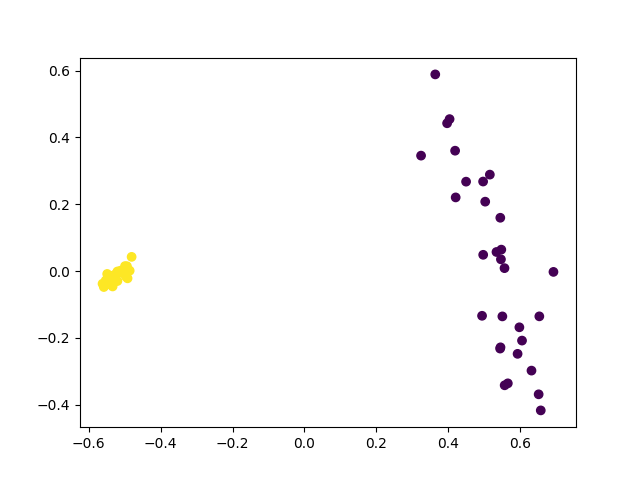
Nice! Even in the presence of noise we still have a clean separation of the two classes. This shows that using entanglement can make a big difference to learning.
References¶
[1] Quantum advantage in learning from experiments, Hsin-Yuan Huang et. al., arxiv:2112.00778 (2021)
[2] Exponential separations between learning with and without quantum memory, Sitan Chen, Jordan Cotler, Hsin-Yuan Huang, Jerry Li, arxiv:2111.05881 (2021)

